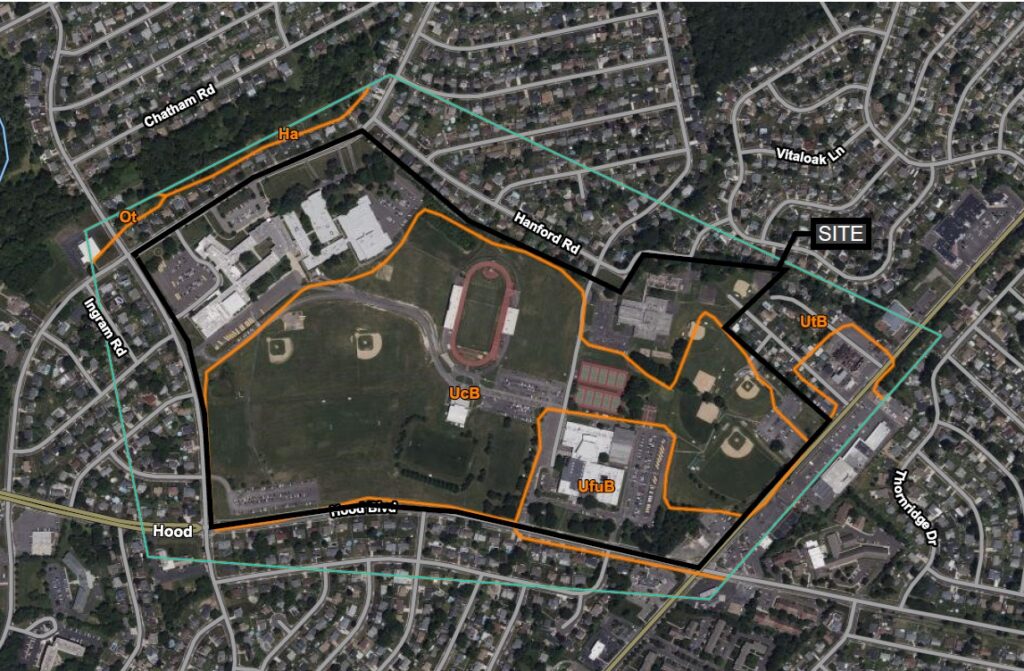Contributors at PSD411 were contacted by whistleblowers, urging them to submit RTK requests concerning geological studies and wetlands assessments for the site proposed for the new PHS building. If you have walked on or near the proposed site, you likely have observed visible puddles and standing water. After heavy rainstorms, field hockey parents can attest that parts of the property feel akin to walking on a sponge.

Wetlands Delineation Work Initiated
Emails obtained by this organization reveal a chain of communications initiated on March 18, 2025, by Facilities Director George Steill. The email thread includes participants such as the PHS building architects from KCBA, as well as representatives from Terraform Engineering and Valley Environment Services.
Valley Environmental Services submitted proposal #2863, which seems to have been approved and signed upon receipt. According to the communications, the survey was conducted on March 27, 2025. Interestingly, despite the recent email chain, the signed and accepted proposal was originally submitted to Pennsbury on July 17, 2024.
Geological Studies Reviewing Soil and Water Levels
On May 15, 2023, Pennsbury engaged Earth Engineering Incorporated (EEI) to conduct a geological study of the proposed construction site. The project’s scope encompassed a field investigation, a study of the site conditions, laboratory testing of soil samples collected during the field investigation, and a preliminary geotechnical engineering analysis. Below is the report Pennsbury received in August 2023 summarizing the study’s findings.
Per the report, in Section IV on Page 3, EEI states that on July 13, 2023, it conducted boring drilling to a depth of 20 feet. No auger refusal or hard augering conditions were encountered, indicating the absence of bedrock or weathered rock formations. Groundwater was found at depths of 13 to 15 feet in three boring locations, while five of the six borings identified groundwater at depths ranging from 6.5 to 13.5 feet.
In Section VI on Page 6, EEI highlights that the soil encountered at the 20-foot depth primarily consists of silt and sand, ranging from very loose to medium density. Furthermore, Section VI on Page 7 notes that the planned construction area is likely to face groundwater challenges, necessitating dewatering measures such as diversion ditches, cofferdams, underdrains, and/or pumps. Finally, in Section X on Page 10, EEI emphasizes that well points will need to be established at an elevation deeper than the excavation depth, with re-establishment of the well points likely required during construction.
In the report, EEI advises that the soft and loose residue identified in the borings will necessitate a review of unstable areas before any structural fill is placed. All soft or loose fill material and natural soils are recommended to be removed and replaced with structural fill. EEI states that undercutting or stabilization should be anticipated. EEI further recommends conducting additional test borings once foundation loads and elevations are established in order to provide a final foundation design recommendation. These details, as noted in Section III on Page 3, were not available prior to the assessment.
A second geological study is currently underway, being conducted by David Blackstone & Associates (DBA). Requests for proposals (RFPs) were distributed in January 2025, with five participants—including EEI—submitting bids. Ultimately, DBA was selected as the new vendor. According to witness accounts, DBA began its property assessments on March 11, 2025.
As part of the study, DBA plans to drill 39 borings to a depth of 30 feet across the property. However, a concerning discrepancy arises in their proposal: the “Proposed Construction” section describes the building as a “new 1 to 2.5 story high school building,” while presentations shared with the Pennsbury community indicate plans for a 3.5-story building.
A copy of DBA’s proposal is available for review below.
Why Does A Wetlands Determine Matter?
The determination of wetlands could necessitate a reassessment of the foundation planned for the construction site. In cases where the land is highly waterlogged, drilling may need to extend to depths of 50 to 100 feet. To ensure the building’s stability and safety, while also withstanding strong wind gusts and seismic activity, deep pilings and soil stabilization may be required.
Additionally, a wetlands delineation would mandate coordination with the Pennsylvania Department of Environmental Protection (DEP) for permit approval. Activities that alter wetlands, streams, or floodways are regulated under Chapter 105 of the Water Obstruction and Encroachment regulations. This review process could significantly delay the project’s launch and lead to added expenses for reengineering the foundation plan, along with substantial cost increases to construct the modified foundation required to comply with wetlands regulations.
If the project impacts wetlands, Pennsbury may also need to implement mitigation measures approved by DEP, such as creating or restoring wetlands elsewhere. The U.S. Army Corps of Engineers might need to be involved as well, particularly for projects requiring 404 permits under the Clean Water Act.
Regardless of DEP’s determinations, the previous Geological Assessment raises concerns about potentially unstable land that will require modifications to safely support a 500,000-square-foot building on a floating slab. With approximately 3,500 individuals—comprising staff, students, and visitors—expected in the building daily, prioritizing the safety and stability of the construction is paramount.